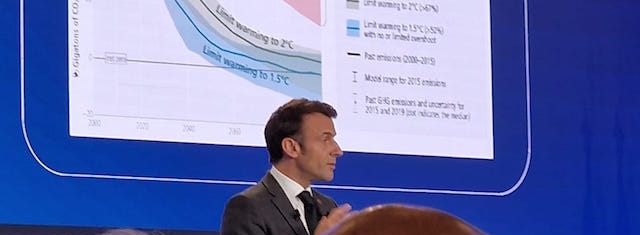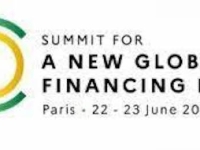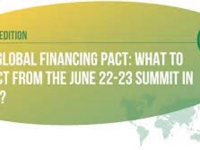Vips
NEW GLOBAL FINANCING PACT SUMMIT TO HOST OVER FIFTY HEAD OF STATES & LEADERS
INVITED BY PRES. MACRON,PARIS 22-23 JUNE

Pres. Macron Elysee Palace (Source: Jedi Foster & Rahma Sophia Rachdi)
USPA NEWS -
President Macron, invited hundred of global leaders, including heads of states, CEOs, leaders from civil society and international institutions (UN, World Bank, IMF), to participate in the « New Global Financing Pact Summit » to be held in Paris, Palais Brogniart, 22-23 June 23. Over fifty head of states and Chiefs of governments have already confirmed their venue.
The summit will take place over two days, it will allow debates at the highest level between Heads of State and Government, heads of international organizations, representatives of civil society, foundations, funds and the private sector.
Over twenty or so high-level events, including Heads of State and Government and representatives of civil society, will be held at UNESCO and the OECD and which are an integral part Summit.
The summit will take place over two days, it will allow debates at the highest level between Heads of State and Government, heads of international organizations, representatives of civil society, foundations, funds and the private sector.
Over twenty or so high-level events, including Heads of State and Government and representatives of civil society, will be held at UNESCO and the OECD and which are an integral part Summit.
OPENING CEREMONY BY THE FRENCH PRESIDENT EMMANUEL MACRON
Testimonials from civil society actors
Messages from Mohamed Bazoum, President of Niger, Mia Mottley, Prime Minister of Barbados, and Antonio Guterres, UN Secretary General
10:15 a.m. - 7:00 p.m.
Fifty themed events
10:30 a.m. - 7:00 p.m
SIX ROUND TABLES
Testimonials from civil society actors
Messages from Mohamed Bazoum, President of Niger, Mia Mottley, Prime Minister of Barbados, and Antonio Guterres, UN Secretary General
10:15 a.m. - 7:00 p.m.
Fifty themed events
10:30 a.m. - 7:00 p.m
SIX ROUND TABLES
REVISING THE MODEL OF MULTILATERAL DEVELOPMENT BANKS TO FACE THE PROBLEMS OF THE 21ST CENTURY
CONTEXT & MAIN ISSUES TO BE DISCUSSED
In the context of multi-sectoral shocks, with the risk of developing countries taking divergent paths, three major shifts need to be considered: (i) a change in approach to reconcile climate and biodiversity protection with development in all development financing institutions, (ii) a change of scale by mobilizing all our instruments and partners to continue to move forward following the first encouraging results of the review of the adequacy framework capital (CAF), (iii) a change of methods to ensure that the multilateral development banks (MDBs) work in symbiosis, but also hand in hand with the other development instruments, and that the funds for the climate and the environment work effectively.
CONTEXT & MAIN ISSUES TO BE DISCUSSED
In the context of multi-sectoral shocks, with the risk of developing countries taking divergent paths, three major shifts need to be considered: (i) a change in approach to reconcile climate and biodiversity protection with development in all development financing institutions, (ii) a change of scale by mobilizing all our instruments and partners to continue to move forward following the first encouraging results of the review of the adequacy framework capital (CAF), (iii) a change of methods to ensure that the multilateral development banks (MDBs) work in symbiosis, but also hand in hand with the other development instruments, and that the funds for the climate and the environment work effectively.
KEY QUESTIONS TO GUIDE THE DISCUSSION
• How do we increase our ambition for capital optimization of multilateral development banks? What level of ambition is required in terms of quality for the next replenishments, and under what conditions should a capital increase be considered?
• How can we mobilize more private funding for international financial institutions and how to bring these institutions closer to private funds and foundations?
• How can we make it easier for countries that need it most to access concessional finance? To this end, how should the definition of vulnerability be revisited?
• How can we ensure that all actors work together in an "ecosystem" and improve their cooperation on the ground? How can the operation and use of capital from existing vertical climate funds be improved?
• How do we increase our ambition for capital optimization of multilateral development banks? What level of ambition is required in terms of quality for the next replenishments, and under what conditions should a capital increase be considered?
• How can we mobilize more private funding for international financial institutions and how to bring these institutions closer to private funds and foundations?
• How can we make it easier for countries that need it most to access concessional finance? To this end, how should the definition of vulnerability be revisited?
• How can we ensure that all actors work together in an "ecosystem" and improve their cooperation on the ground? How can the operation and use of capital from existing vertical climate funds be improved?
A NEW METHOD: PARTNERSHIPS FOR GREEN GROWTH
Moderation: Catherine Colonna, French Minister of Foreign Affairs / Grand auditorium – Palais Brongniart
Mr. Denis SASSOU-NGUESSO, President of the Republic of Congo
Mr. Abdel FATTAH AL-SISSI, President of the Arab Republic of Egypt
Mr. Cyril RAMAPHOSA, President of the Republic of South Africa
Mr. Gustavo Petro URREGO, President of the Republic of Colombia
Mr. Mohammed Bin Salman Bin Abdulaziz AL-SAOUD, Crown Prince, Prime Minister, Minister of Defense of the Kingdom of Saudi Arabia
Ms Ursula VON DER LEYEN, President of the European Commission
Mr. SANJAYAN, CEO Conservation International
Moderation: Catherine Colonna, French Minister of Foreign Affairs / Grand auditorium – Palais Brongniart
Mr. Denis SASSOU-NGUESSO, President of the Republic of Congo
Mr. Abdel FATTAH AL-SISSI, President of the Arab Republic of Egypt
Mr. Cyril RAMAPHOSA, President of the Republic of South Africa
Mr. Gustavo Petro URREGO, President of the Republic of Colombia
Mr. Mohammed Bin Salman Bin Abdulaziz AL-SAOUD, Crown Prince, Prime Minister, Minister of Defense of the Kingdom of Saudi Arabia
Ms Ursula VON DER LEYEN, President of the European Commission
Mr. SANJAYAN, CEO Conservation International
A NEW WAY: GREEN GROWTH PARTNERSHIPS
Addressing the intersecting challenges of climate, biodiversity and development requires developing a new way to deliver results under the 2030 Agenda both globally and locally. Because financial actors (development banks, financial institutions, international organizations, philanthropic foundations, sovereign wealth funds, pension and investment funds, companies) may have different interests, objectives and methods, bring them together through strong frameworks based on country goals can make all the difference. Ambitious multi-stakeholder partnerships can be useful in many areas to scale up efforts, such as partnerships for a just energy transition, enabling access to technologies and innovation and preserving biodiversity (national packages of measures for forests, nature and climate). This type of partnership can help mobilize a wide range of international and national, public and private financial instruments, such as concessional loans, guarantees, debt swaps, carbon markets, hybrid finance and investments.
States play a key role in establishing these multi-stakeholder partnerships. By developing long-term strategies with clear and ambitious goals, in line with the Sustainable Development Goals (SDGs), the Paris Agreement and the Global Biodiversity Framework from Kunming to Montreal, and building on detailed investment plans, states can implement incentives for more targeted and efficient use of both international and domestic resources. Multi-stakeholder partnerships can make it possible to move from a project-based approach to a more global and systemic approach in which each stakeholder has a clearly defined role. Learning from existing partnerships to ensure optimal use of financial resources, how to define, for each country and region, a better coordinated approach based on the needs expressed by the countries? How do we ensure that these national partnerships act at the right scale around the world to fight climate change and protect biodiversity, including forests and oceans, in the run-up to the 25th United Nations Ocean Conference?
KEY QUESTIONS TO GUIDE THE DISCUSSION
• What lessons have been learned from existing multi-stakeholder partnerships (such as the Just Energy Transition Partnerships with South Africa, Indonesia or Vietnam)?
• What are the key principles that condition the success of these multi-stakeholder partnerships?
• What should be the role of international financial institutions within these multi-stakeholder partnerships?
• How can these partnerships help leverage more private investment? What instruments are useful for doing this?
• In addition to the energy transition, in what other priority areas should we establish these multi-stakeholder partnerships? How can they support biodiversity and forest programs?
• How to ensure that these multi-stakeholder partnerships contribute to the development of viable project packages? How can these partnerships be complemented by other capacity building initiatives or measures for project preparation or private sector engagement (through guarantees and other similar instruments)?
• How can carbon markets help support such partnerships in a fair and efficient way?
• What lessons have been learned from existing multi-stakeholder partnerships (such as the Just Energy Transition Partnerships with South Africa, Indonesia or Vietnam)?
• What are the key principles that condition the success of these multi-stakeholder partnerships?
• What should be the role of international financial institutions within these multi-stakeholder partnerships?
• How can these partnerships help leverage more private investment? What instruments are useful for doing this?
• In addition to the energy transition, in what other priority areas should we establish these multi-stakeholder partnerships? How can they support biodiversity and forest programs?
• How to ensure that these multi-stakeholder partnerships contribute to the development of viable project packages? How can these partnerships be complemented by other capacity building initiatives or measures for project preparation or private sector engagement (through guarantees and other similar instruments)?
• How can carbon markets help support such partnerships in a fair and efficient way?
Liability for this article lies with the author, who also holds the copyright. Editorial content from USPA may be quoted on other websites as long as the quote comprises no more than 5% of the entire text, is marked as such and the source is named (via hyperlink).







